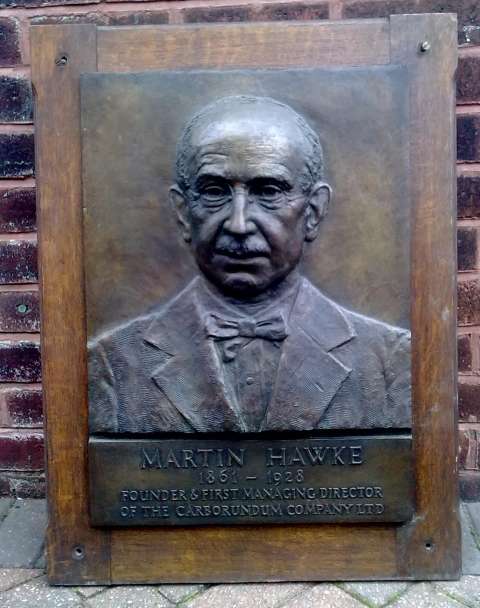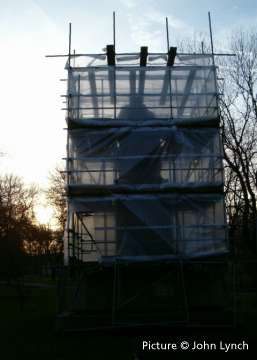
This site celebrates the life and work of sculptor John Cassidy (1860 - 1939).
This page is for news, comments from readers and other odds and ends that don't need their own page.
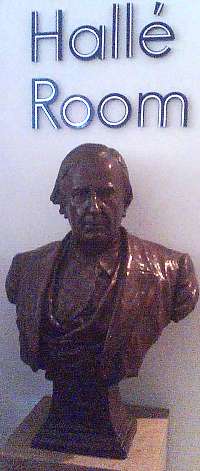
Bust of Sir Charles Hallé, Bridgewater Hall, Manchester.
News and comment: updated 20 June 2020
Colston in the news
Rarely has a work by Cassidy generated so much national publicity as the Bristol state of Edward Colston in Bristol, which was pulled down by 'Black Lives Matter' protesters in June 2020 and pushed into the water of the nearby dock. Cassidy himself was rarely mentioned in the ensuing media storm, as is so often the case with public sculptures. Colston was arguably a legitimate target, as he was closely involved in the appalling slave trade, but in subsequent days the danger has spread to other public works around the UK portraying people who were judged guilty of any form of racism, including Churchill, Baden-Powell, and William Gladstone, as well as Cecil Rhodes whose statue in Oxford has been a source of unrest for some time, and even the likes of Nelson and Drake. Several statues of Robert Peel (younger or elder?) in the Manchester area are among the accused.
This brings into focus the question of what public statues portraying real people are for. The usual procedure is that someone thinks a dead person needs to be kept in the public's mind, raises some money, usually with the help of some others, commissions a work, and persuades a land-owner - often a local council - to provide a location. In Victorian days and before, the subject would be some thought to have done 'good works' or maybe won a battle; however in many cases the passing pedestrian has no idea at all who the person might be or what they have done.
The idea fell out of favour in the twentieth century, but recently we have seen many new works appearing, including belated tributes to suffragists, and increasingly, entertainers in their home towns. The problems start when, in addition to the reason for the honour, the other activities and opinions of the memorialised are explored. (Was Ben Brierley a racist, for example? Whether he was or not, his statue was pulled down by vandals in 1980.) What about politicians who may have voted against female suffrage? Cotton factory owners who condoned slavery and paid their own workers a pittance?
The list goes on ... you can even choose your target from an online list - but what is our opinion? Don't know. Maybe we should be careful who gets a statue in the future.
'Adrift' to return
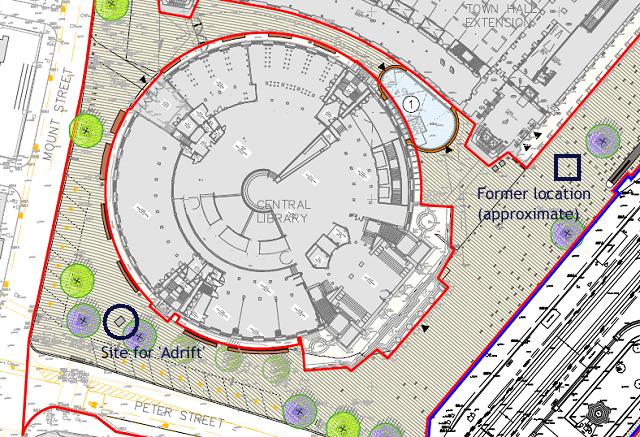
As recorded in our feature on Cassidy's masterwork 'Adrift', the sculpture was removed from its location in St Peters Square, Manchester and placed in storage to make way for the building site which is the refurbishment of the Central Library and Town Hall Extension. Since then, plans have been developed for the reconfiguration of the square itself to improve its appearance and also allow for an enlargement of the Metrolink tram station. Planning permission for these changes has now been given, and work has begun. We are please to say that permission was granted on condition that 'Adrift' should be returned to the square in a position approved by the City Art Gallery. The map extract above shows the proposed location, which is outside the square itself, to the side of the library among some trees.
The proposed site in March 2013 is occupied by ugly temporary buildings related to the work on the Library. We'll need to wait for these to be removed (sometime in 2014?) to get an idea of how the sculpture will 'work' in the area. It has to be remembered that the work was never intended by its artist, or James Gresham who commissioned it, to be an outside landscape feature, but better to be outside that not seen at all.
Cassidy in Print: Our essay about John Cassidy and his Manchester patrons has now been published in the Bulletin of the John Rylands University Library of Manchester, as part of a theme issue on Manchester Architecture. The full list of contents of the issue 'Architecture and Environment: Manchester in the Nineteenth and Twentieth Centuries' is:
Hebbert, Michael: Introduction
[by the guest editor]
Hodgson, John: 'Carven stone
and blazoned pane': The Design and Construction of the
John Rylands Library
Barter, Marion and Hartwell,
Clare: The Archirecture and Architects of the Lancashire
Independent College, Manchester
Connelly, Angela: 'A pool of Bethesda': Manchester's First Wesleyan Methodist Central Hall (2012)
Morris, David: 'Here by experiment': Edgar Wood in Middleton (2012)
Jolley, Victoria: An Unsuspected Skyline Rival: Lee House, Great Bridgewater Street, Manchester (1928-31) (2012)
Cunliffe, Steve and Wyke, Terry: Memorializing its Hero: Liberal Manchester's Statue of Oliver Cromwell (2012)
Hulme, Charles: John Cassidy, Manchester Sculptor and his Patrons: Their Contribution to Manchester Life and Landscape (2012)
Perkins, Chris and Dodge, Martin: Mapping the Imagined Future: The Roles of Visual Representation in the 1945 City of Manchester Plan (2012)
Crompton, Andrew: Manchester
Black and Blue (2012)
For more about the Bulletin see our list of contents back to Volume 1.
Sheila Crehan of the Slane History and Archaeology Society writes: 'Our activity for Heritage Week was a John Cassidy walk on 23 August. People assembled at St. Erc's cemetery carpark at 7 pm. We were supported this year by a large group from Rathfeigh Historical Society whose members deserve great credit as it was a very wet evening. It rained incessantly during the walk. Shelter was taken along the way under trees and hedges and beside large vans and walls.
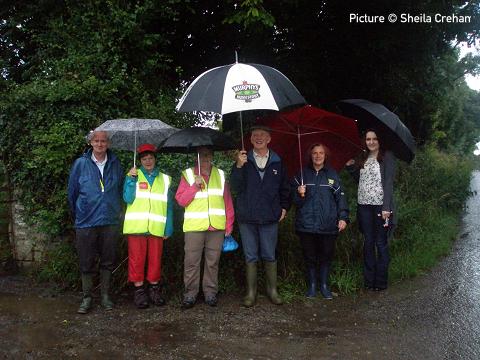
'Some walkers succeeded in reaching the gate which opens to the laneway that leads to the dilapidated remains of Cassidy's birthplace. The very inclement weather forced others to return to their cars.'
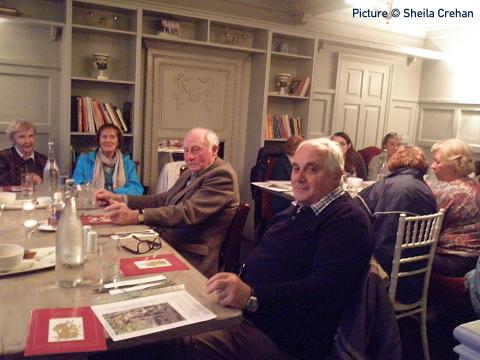
'Afterwards we ended up in the local Conyngham Arms hotel where a lively discussion on Cassidy took place and where images of some of the sculptor's work were passed around. Refreshments were served and despite the rain we all felt happy with our effort.'
'Ship Canal Digger' lost to view
News from Manchester
City Galleries: 'From Monday 9 January 2012, the
Manchester Gallery will be closed while we renew the
display. It will reopen at the beginning of May with an
installation of international contemporary art inspired by
Manchester.'This refers to the room on the ground floor of the Mosley Street gallery devoted to art works relating to Manchester. This has in recent times been the only place in the Gallery where a Cassidy work - 'The Ship Canal Digger' could be seen, which thus joins 'Adrift' in (hopefully) temporary obscurity.
'Adrift' taken away
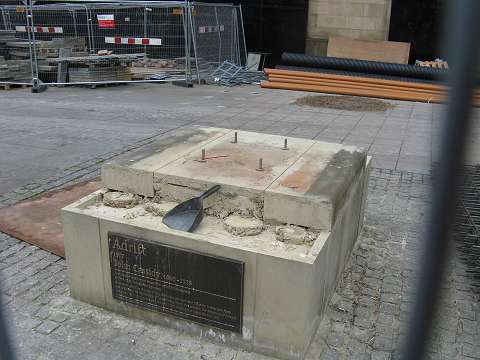
Above: the site of Cassidy's major work 'Adrift' in St Peters Square, Manchester, as seen on 13 April 2011, now amid builders' detritus connected with the 'improvements' going on in the Town Hall and Library. 'Adrift' has been removed and placed in safe storage as if was feared it would be damaged. We are assured that it will be replaced when the work is complete - maybe in 2013.
 RSS Feed
now available
RSS Feed
now available
You can now find out about news articles on this site without visiting it, but subscribing to our new RSS Feed. This will automatically add new messages in your email or web browser program telling you that each new or updated article is available.
There are many ways of subscribing to RSS feeds, too many for us to explain them all, but here are links to instructions for Internet Explorer 7, Windows Live Mail, Google Reader, Firefox, Gmail ... Hotmail does not appear to have an RSS reader, sadly. I (C.H.) find that Mozilla Thunderbird, a general-purpose email program, is particularly good for both email and RSS-reading on the same screen.
The address of the feed to enter in your reader is:
http://www.johncassidy.org.uk/rssfeed.xml
Gravestone refurbished
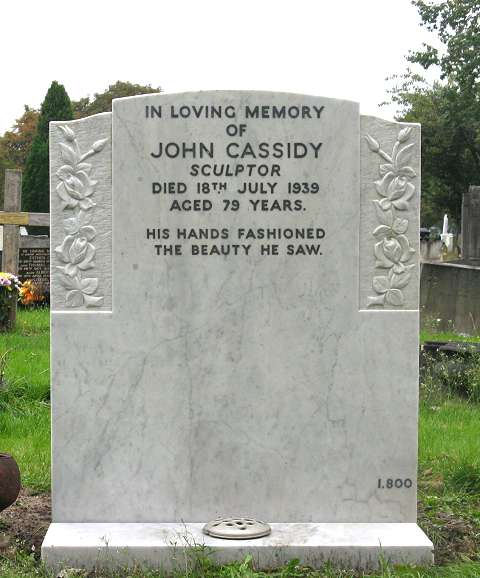
Thanks to funding from members of the Slane Historical Society, John Cassidy's grave in Manchester Southern Cemetery was cleaned and 'reset' during the summer of 2010, Cassidy's 150th birthday year. Compare this view with the pictures from 2009 below to see the remarkable difference. The work was done by the skilled craftsmen of local firm James Hilton, and fine job was done too.
The original James Hilton was a comtemporary of Cassidy: he founded his firm in 1867, initially in the City Centre and later, as now, opposite the cemetery. Born in Lockwood, near Huddersfield, Yorkshire, he came to Manchester in about 1862, marrying Ruth Edwards (born in Denbighshire, Wales) there in 1863. The 1871 Census shows James Hilton, Sculptor, aged 33, living with his wife Ruth, his children Jane and Albert, and a lodger named John Taylor, an apprentice, at 28 Francis Street, Chorlton-on-Medlock. By 1881 the family are at 57 Molyneux Street, C-on-M, and James, now described as a mabrle mason, has prospered enough to employ a servant, Fanny Taylor. The 1891 census has Ruth and Jane living at 16 Clarendon Road, C-on-M and looking after two boarders. In 1901, aged 63, he was living with only a housekeeper at 53 Molyneux Street, and describing himself as a sculptor, while Ruth was living at 266 Stockport Road, Levenshulme with Jane, her husband James Somerville Crawford and their daughter Ruth. His son Albert Edward took up a different trade, becoming a signwriter, and by 1911, living at 11 Lancaster Road, Fallowfield with wife Mary and daughter Dorothy, he describes himself as a 'sign expert.'
James Hilton died in about 1908 but the firm he founded continues under his name to the present day.
Slane village to have a heritage centre
From the Meath Chronicle, 1
September 2010:
Meath County Council was
the proud recipient of a piece of the heritage of Slane
when the Marquess Conyngham, Henry Mountcharles, gifted
the Cavan Row Cottages in the village to the council. The
official handover took place in the council chamber in the
presence of the cathaoirleach, Cllr Ann Dillon-Gallagher,
the county manager, Tom Dowling, and members of the Slane
Historical Society.
Speaking at the handover ceremony, Lord Mountcharles said
he would like to see the cottages become a focal point of
the village. "Slane is one of the most significant 18th
century villages in the country and it needs a boost in
terms of getting a heartbeat in its centre," he said.
Meath County Council says it intends to refurbish the
cottages and develop them into a heritage and tourism
centre.
John Cassidy
Commemorative Walk
As part of Heritage Week in Ireland there was a
guided walk around the Village of Slane organised by the
Slane
Historical Society
to commemorate the 150th anniversary of the birth of
John Cassidy, visiting the site of his birthplace and
the village where he grew up.
A recently-discovered work
This commemorative plaque for Martin Hawke, 1861-1928, signed on the back 'John Cassidy RBS 1929' was recently brought to our attention by the current owner.
The Carborundum company was formed in the USA in 1891 to manufacture industrial abrasives. The company history relates:
Carborundum opened its British subsidiary in 1913, with Martin Hawke as Managing Director, and established a factory in the Trafford Park industrial estate in Manchester.
Martin Hawke was actually born in 1862, in Cornwall, the son of an ore dresser in the tin mining industry. He married Bessie Hill, from Plymouth, and the couple emigrated to the United States in 1886 where he found a job with the Carborundum company and rose to a managerial position, becoming an American citizen. His sons Irving Joseph Hawke and Clarence Ewart Hawke also worked for the company. He returned to England to set up the Trafford Park factory, and made his home at 'Maynwood', Leicester Road, Hale, Cheshire, a wealthy suburb of Manchester. His name appears many times on the passenger lists of transatlantic liners, although he must not be confused with another Martin, later Lord, Hawke who was a famous cricketer of the day.
After several mergers and changes of ownership, the company changed its name in 1997 to Carbo PLC, and in 2004 the Manchester factory was closed down, and later demolished, production being transferred to Germany.
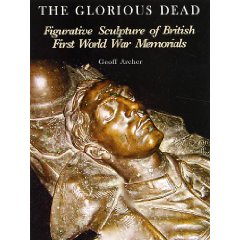 'The Glorious Dead'
'The Glorious Dead'
The Glorious Dead, a new, and very exhaustive book on the figurative sculptures on British war memorials, written by Geoff Archer, was published in November 2009 by Frontier Publishing of Norfolk. Mr Archer is himself an artist as well as a historian: his website gives examples of his paintings. The book has developed from an interest in his local memorial, leading to travel over the UK visiting others.
Cassidy's large memorials are listed and illustrated, as well as those of many other sculptors of the time who created figures for memorials, mostly in the 1920s. The book has 416 pages, and 260 black-and-white pictures, nearly all taken by the author himself. The book costs £30.
A 70th anniversary tribute
Notes and pictures by Charlie Hulme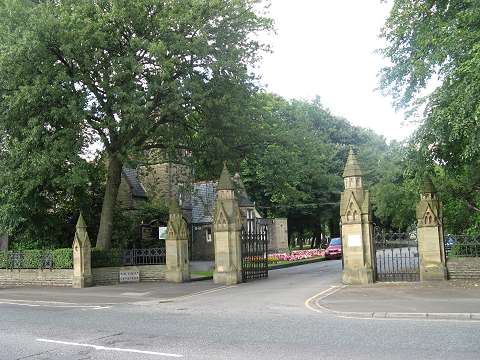
Aware that the 70th anniversary of Cassidy's death was approaching, on 15 July I made a visit the man's grave, in Manchester Southern Cemetery, Chorlton-cum-Hardy, three miles south of the City Centre. The picture shows the main entrance on Barlow Moor Road.
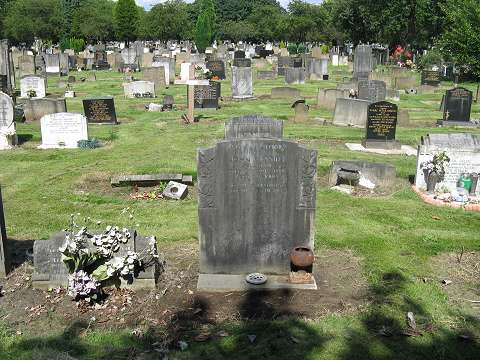
Opened in 1879, the burial grounds and associated chapels cover a wide area - 168 acres (68 Hectares) according to one source - divided into sections according to religion: Cassidy lies in the Roman Catholic section (see out Last Days feature for details) where understandably there is a preponderance of Irish surnames, with some Polish ones, especially from more recent years. The upkeep of the place is a credit to Manchester City Council: it is a pleasure to walk through its wooded glades. Cassidy's simple headstone is shown above. Unfortunately, in recently years the authorities have ordered some of the stones to be laid down on the ground in case they fall on someone, but John's stone has happily not suffered in this way.
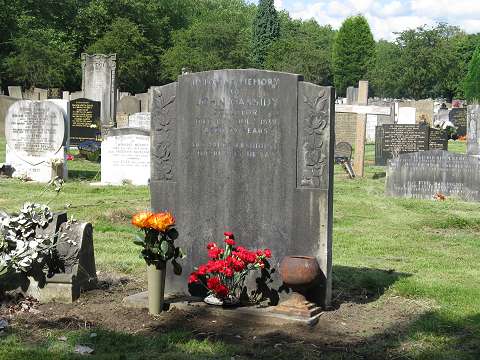
A walk to one of the flower shops in the nearby streets produced some flowers to brighten up the scene for the anniversary, and also something extra to hold them, as the cast-iron urn on the right is sadly rusted through. When I visited at 3pm, the sun was shining full on the stone.
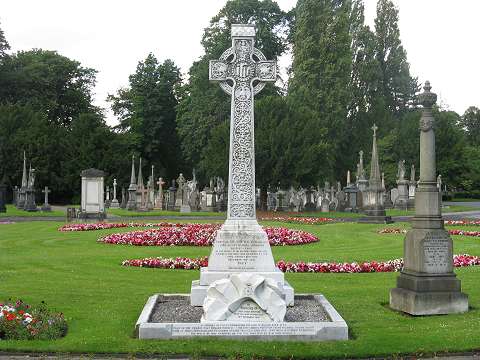
A circular area in the centre of the Cemetery has the memorials of some of the more 'notable' occupants: the impressive celtic cross above is for Sir John W. Alcock, pioneer transatlantic flyer and subject of a Cassidy memorial in the Town Hall - see our feature Down in Albert Square.
Fountain conservation completed
Manchester City council are doing a fine job conserving Cassidy's work in the City centre. Following the restoration of King Edward (below) and the re-appearance of 'Adrift' (see special page) work began in April 2009 on the Jubilee Fountain in Albert Square:
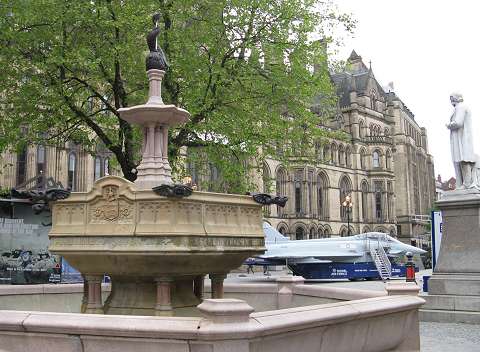
... and here it is completed in May 2009. (The aircraft is part of a Royal Air Force recruiting event.) Our special thanks are due to Mr Strittmatter, Programme Manager for Public Arts and War Memorials, for his enthusiastic support for John Cassidy's work.
'Adrift' in the news
We are no the only ones who have been photographing 'Adrift' - here are some fine views on Flickr by Joseph McCarraghy.
An item about the revival of the work appeared in the Manchester Evening News on 2 April, thanks to Tony Frankland, a volunteer at the Museum of Science and Industry, who has been 'quietly campaigning' for 'Adrift' to be re-instated and wrote to the M.E.N's postbag in February. Note, however, that the unveiling of the plaque on the sculpture will not take place in April as suggested by the article: it will be a little later this year.
Neither are we aware of the 'John Cassidy Appreciation Society' mentioned in the item. If anyone knows of such a body, please let us know.
Another, very interesting and accurate, article (by Jonathan Schofield) can be found on the Property Confidential website. Quote:
Yes, it shows Cassidy was a competent sculptor who could handle emotion. He’s not a Rodin (his contemporary) but he can still sculpt powerfully. The mother and baby are handled very well, the body and features of the mother tight with devotion, misery and worry for her child, despite her own tenuous hold on life. I’m not sure that the new siting is any good at all, the work is surrounded by street furniture and too close to the road and the buses. It could do with more room to breathe but then it is occupying the site of another sculpture. Perhaps it should be facing the Midland as well, rather than the 84 from Chorlton and the trams to Altrincham.
Well, yes, it does rather look as though the father is trying to flag down a passing bus...
Spruce-up for King Edward
|
|
This picture, taken
by John Lynch on 27 February 2008, shows Cassidy's King Edward VII
in Whitworth Park, Manchester shrouded in
scaffolding and plastic sheets. Planned conservation work includes cleaning, repatination, and, we are very pleased to hear, replacement of the King's lost sceptre and the cross from his orb. Expected date of completion is the end of April 2008. Our King Edward VII page has been updated with new pictures, quotes and background information. |
Cassidy and Hallé 150
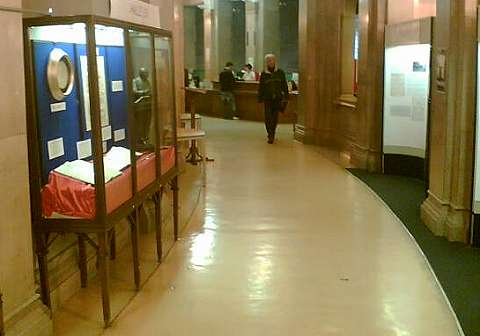
The exhibition commemorating 150 years of the Hallé Orchestra, in the Local Studies Library of Manchester Central Library, St Peters Square in 2008 included, as well as various Hallé memorabilia and displays on the history of the orchestra, the small Cassidy bronze by (approx. 70cm high) statue of the founder, Sir Joseph Hallé, which is normally kept in the Principal's Office of the Royal Northern College of Music.
This was, according to the caption, presented to the College of Music by Mrs Walter Beer. Mrs Walter Beer was formerly Lucy Huckett, who with her sister Fanny had lived at Longford Hall with Mrs Rylands as 'adopted nieces.' Water Beer was a Manchester cotton merchant.
There is a bust of Hallé, also by Cassidy, on permanent display in the foyer of the nearby Bridgwater concert hall, the home of the Hallé Orchestra.
